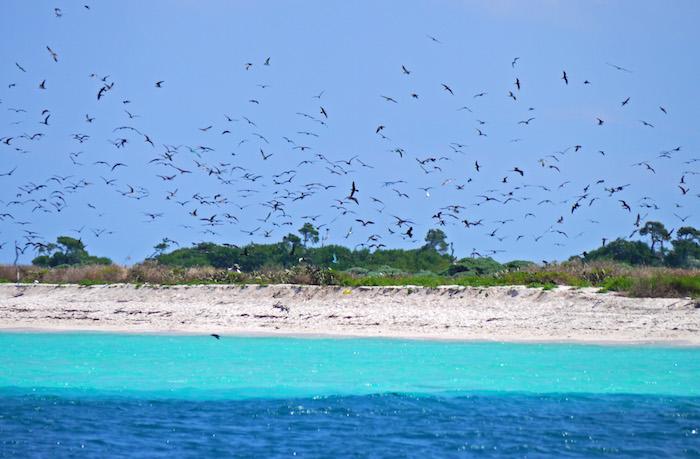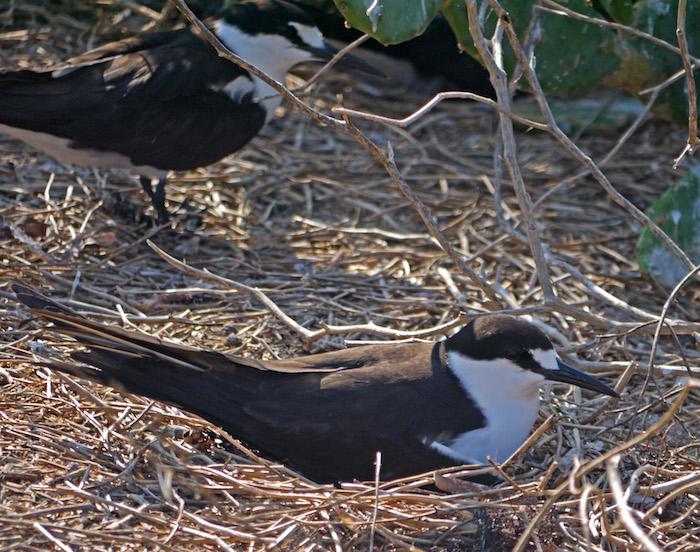
The health of Sooty terns is a good indicator of the health of the oceans/Erika Zambello
When I think back to my week camping within Dry Tortugas National Park, I remember the sounds beyond all else. Throughout the day and into the deepest hours of the night, the cacophony of seabird calls reverberated across the small islands and brick walls of Fort Jefferson. The Sooty terns, Brown noddies, and Magnificent frigatebirds constantly swirled above their breeding grounds, creating a dynamic, ever-changing landscape.
I was in the Dry Tortugas for a week as part of a Duke Nicholas School of the Environment spring break trip during graduate school. A group of students and I had carpooled down from North Carolina to band Sooty terns with unique identifying bands as part of a decades-long study monitoring populations of these breeding seabirds. Every day, we headed out into the breeding colony to net the Sooty tern adults, carefully holding the birds while we recorded numbers from their leg bands or attached new bands. As we worked on the sandy beach, hundreds of birds came and went from the breeding colony, flying over the aquamarine waters surrounding the islands.

Sooty terns are among the many species that wheel in the sky over Dry Tortugas National Park/Erika Zambello
With us that week as a teaching assistant was Ryan Huang, a PhD student studying the terns as part of his dissertation in conservation biology. Since I visited in 2014, Huang (Disclaimer: Huang is also my business partner at a small, creative communications consultancy) has continued visiting the colony to band the birds, and also to attach tiny telemetry tracking devices to them, watching their daily movements. With the banding and telemetry data, Huang is publishing a paper in PeerJ about the movement of the Sooty terns after they leave the Dry Tortugas.
“This project has actually been going on for decades before I was even born,” Huang explained.
Interest in Sooty terns stems from their role as an indicator species for open ocean-level ecosystem processes; if their populations decline, it's considered a warning sign for the open ocean. Tracking them to see where they go gave scientists a better understanding of what ocean area they "monitor."
The banding project began in 1939, and more than 100,000 birds have been banded thus far. The dataset is so large it occasionally crashed Huang’s computer! He came on to the project in 2013, ready to tackle the mountain of data as well as add the new telemetry study.
It’s hard to choose a more beautiful location to perform field work.

Ryan Huang, right, has been studying Sooty terns at Dry Tortugas National Park to determine where they go when they leave the park/Erika Zambello
“The Dry Tortugas National Park is a really amazing place to be. I love it every time I go, it’s just such an interesting place that is rich not only in biodiversity, but culture and history too," he said, adding, ”(A)s for my research, it’s always fun to get out to the colony and see how many birds I can catch.”
After years of work, Huang has created maps of where the terns actually go. Tracking the geolocators, Huang literally watched (from his laptop) two tagged terns as they traveled into the Gulf of Mexico, then south off the coast of South America. Looking specifically at feeding patterns, he concluded that the terns had little overlap with oil impacts from the Deep Horizon spill and other anthropogenic effects (so far). Unfortunately, their trajectories do overlap with areas often affected by hurricanes and tropical storms, and his research showed a relationship between Sooty tern mortality and tropical storms.
“The tracking data was revolutionary in how we see these birds since we had no idea where they went after they left the colony,” Huang explains, “Now, we not only know where they go, but also when they’re there, which was an essential component to understand how they overlap with hurricanes in time and space.”
In the evenings, we intrepid bird banders were free to explore as the sun set, the shadows cast by our tents elongating against the grass. In addition to Huang’s important conclusions about what had been a wildlife mystery, the bird banding program has introduced dozens and dozens of young ecologists to the intricacies of bird banding as a research discipline, and the awe of close contact with a beautiful seabird colony.

A Sooty tern up close/Erika Zambello
According to Bird Life International, “Seabirds are amongst the world’s most threatened group of birds.”
On the open ocean, they are vulnerable not only to storms, as Huang documented, but also to plastic pollution and fishermen by-catch. When breeding, feral cats and habitat destructions threatens both nests and chicks. Finally, their wide-ranging habits cross international boundaries, making conservation policies especially difficult to design and implement. Little is known about seabirds in general, which is why ecologists like Huang, the students from the Duke Nicholas School, and their research initiatives are critical to protecting these species.
If you’re not an ecologist, there are still many ways you can help the seabirds:
1) Learn about them and share what you know! The American Bird Conservancy has great information on some of the most imperiled seabird species here.
2) Donate to the National Park Conservation Association to support the system that in turn supports many colonies of these birds, or to other seabird conservation organizations.
3) Avoid plastics when possible, and always keep plastic debris out of waterways and off beaches. To learn more about Huang’s study, watch for his article in PeerJ.



Comments
Good read. The Sooty Terns at Dry Tortugas are a phenomena worth experiencing. Great work by these Duke students continuing the decades of incredible scientific research that has been performed before them.
I was part of the banding "crew" in the 70's Lead by my dad, Glen E. Woolfenden and William (Bill) Robertson. Wonderful memories! When is the last time this was done? 2014? [email protected]